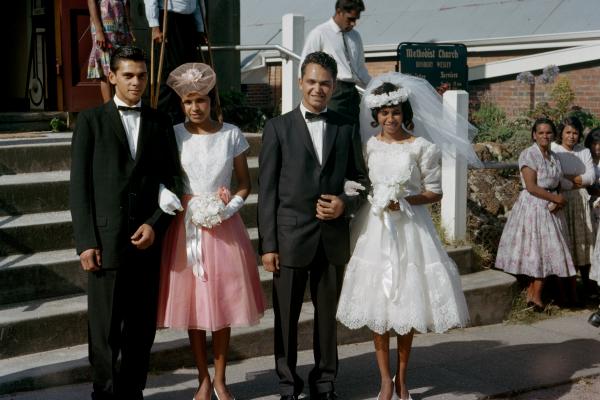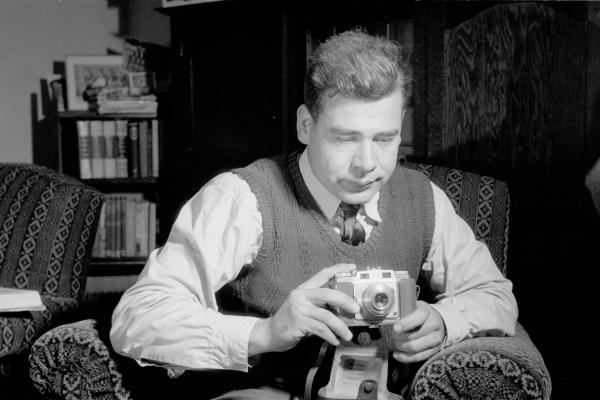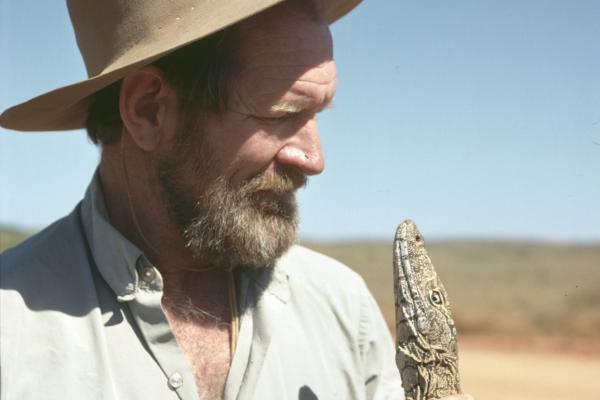The British conducted three nuclear tests on the Montebello Islands between 1952 and 1956. The Montebello Islands (also referred to as Monte Bello) is an archipelago of about 174 small islands located 120km off the Western Australian coast.
Test 1 exploded inside the hull of the HMS Plym anchored in 40 feet of water, 400 yards offshore. The explosion occurred 2.7 m below the water line, leaving a saucer-shaped crater on the seabed, 20 feet deep and 1,000 feet across. The bomb was placed inside a ship because they were worried that a bomb might be snuck into harbours via a boat and wanted to know what would happen.
Tests 2 and 3 were the most powerful detonated in Australia. The final test was six times bigger than the Hiroshima bomb.
In 1985 The McClelland Royal Commission into the nuclear tests found “The presence of Aborigines on the mainland near Monte Bello Islands and their extra vulnerability to the effect of fallout was not recognised by either [Atomic Weapons Research Establishment – UK] or the Safety Committee. It was a major oversight that the question of acceptable dose levels for Aborigines was recognised as a problem at Maralinga but was ignored in setting the fallout criteria for the Mosaic (Montebello) tests.”
In 1959, Kenneth Buller was part of an expedition to the Montebello archipelago four years after it was blasted by atomic bombs. A taxidermist and naturalist at the WA Museum, his task was to inspect what the British nuclear testing had done to the island's fauna and flora. As well as collect and preserve specimens. You can listen to his oral history on the State Library catalogue.
Below you can watch two silent Channel 7 newsreels from 1952 about the testing and a selection of photographs from the State Library of WA collection.
In the State Library catalogue you can flip through a digitised photograph album charting the arrival of the British in Onslow and the subsequent atomic testing.
Recorded live on ABC Radio Perth on 10 February 2023.
Transcript
(Beginning of Interview)
Dustin Skipworth: It's time to take a deep dive into the 1950s at Montebello Islands where the British were conducting some tests and joining us in the studio is Charles Haynes from the State Library. Good afternoon to you Charles.
Charles Haynes: Hello to you Dustin.
Dustin Skipworth: First time we've actually met in person, even though we've worked together for a few years now.
Charles Haynes: It's a beautiful thing, Dustin.
Dustin Skipworth: It's great to have you up here. We're going to talk about the Montebello Islands. Take me back, a little bit ,and paint the picture of what year we're going to and what was going on there.
Charles Haynes: Ok, we're going back to the early 1950s. It's the time of the Cold War and in the context of this story, the Russians have just exploded a nuclear bomb, the Americans already had it. The British were a little bit miffed because they felt that they had actually help create this nuclear beast, but the Americans weren't helping them out in terms of sharing the information, so the Brits thought “Well, let's go it alone. Let's have our own nuclear bomb”. The issue being is that it is pretty tricky to set off or test a nuclear bomb in downtown London...
Dustin Skipworth: [Laughs]
Charles Haynes: ...so they had to find a place to do that and so at some stage they somehow decided that the Montebello Islands, way up north of West Australia, about 120kms west of Dampier, was a good spot and so the British Prime Minister sent a secret telegram to our Prime Minister, Bob Menzies, saying "Do you mind if we just blow up your island quietly?"
Dustin Skipworth: Your island…
Charles Haynes: …and Bob said "Yep, no problems" and off they went! And in 1952, Britain became the third country to explode a nuclear bomb on our islands in Montebello and what they did was they put this nuclear bomb, which was about... it resulted in a yield perhaps twice as much as Hiroshima into a boat because they were a bit little worried that people were going to smuggle nuclear bombs into boats, take them into the harbour in London for example, and then blow them up and what would happen?
Dustin Skipworth: Yeah?
Charles Haynes: Well now we know. So, if you put a nuclear bomb into a boat, a frigate in this case, just under the waterline, press the button, off goes the bomb. The ship is... disintegrates. There's only a propellor left and you're left a hole six metres deep and 300 metres long.
Dustin Skipworth: Wow!
Charles Haynes: And that was the first nuclear bomb exploded in Australia. Later there'd be some other ones in 1956, a couple more and some more in South Australia.
Dustin Skipworth: Charles Haynes from the State Library of WA. It's just gone a quarter past two here on ABC Radio Perth and WA. We're talking about the Montebello Islands and the nuclear bomb that was detonated back in the '50s. How much devastation are we talking from this bomb that’s gone… that went off?
Charles Haynes: Well, as I've said, the first bomb, was detonated under the water and so blew up a giant hole.
Dustin Skipworth: Yeah.
Charles Haynes: 300 metres long, six metres deep, big hole.
Dustin Skipworth: So, just in the water. Not actually on the island.
Charles Haynes: No, this is under the water, next to the island, the first one.
Dustin Skipworth: Ah, got you.
Charles Haynes: The second two were actually on towers and they were much, much bigger. Oh, the third one was much, much bigger. In fact, it was 96 kilotons, which is a hell of a lot bigger than Hiroshima, which is about 15 kilotons and in fact we only knew it was that big… in 1984, when the information came out 'cos it was only meant to be 60. That was the agreement between Australia and England.
Dustin Skipworth: And someone just decided that they wanted to add a little bit more?
Charles Haynes: A little bit bigger... and so the result of it was, lots of different results. Of course, on that particular island... it was decimated. All the animals, everything was decimated. It looked like Krakatoa.
Dustin Skipworth: Wow.
Charles Haynes: Somebody said… and in fact the email, the reason we're doing this story is because we did this Facebook post about an oral history of a scientist from the museum who went to the islands to see what was the impact of the explosions on the islands and he compared it to Krakatoa - that part.
Dustin Skipworth: Yeah.
Charles Haynes: But surprisingly under the water, not too bad!
Dustin Skipworth: Ah!
Charles Haynes: They even found a rat, a large black rat, somehow, that had survived and was taken down to Perth and it seemed to be fine, so they're pretty hard to kill those rats. However, the bigger issue is what was the impact on the people who were watching or near the...
Dustin Skipworth: And was there a large impact?
Charles Haynes: Well, yes, [laughs] is the simple answer. So, in 1985 there was a Royal Commission into the impact and how these tests were conducted and the reason they did that was because the press at the time, the media, there were stories being pushed that people who were serving for Australia at the time, helping out, in that area were dying young. Not only were they dying young, their children were having problems and there were reports of Aboriginal people near there, who not only saw the explosion, felt the explosion - their hair was dropping out... they were feeling unwell and there were much higher rates of radioactive, associated cancers in those people.
Dustin Skipworth: Mmm.
Charles Haynes: Sad thing is there’s been no compensation as far as I can discover, but yes, the impacts were bigger than just on that island.
Dustin Skipworth: You're going to introduce us to a guest here, Charles. Can you paint the picture of how Annette has come into the picture here?
Charles Haynes: Sure. So, Annette is one of the State Library Facebook family in a sense. So, she had read this post that we did and she thought "Ah! I've got a, I happen to have a photograph” or a little strip of images that she had come to find. I think it was in a couch, but I think Annette can tell you the story…
Dustin Skipworth: Mmm.
Charles Haynes: …and she posted that on our Facebook page and we thought, "Gee, this is amazing!"... and we'd love those, but it turns out that probably they were taken by somebody involved in the Australian Armed Forces, maybe had been on a plane, we don't know and if that is the case, we can't - we in the library can't keep them. They’ll have to go to the National Archives because they're really important and they're basically Government property.
Dustin Skipworth: Well, Annette joins us this afternoon here on ABC Perth and across the State. Good afternoon to you Annette.
Annette: Hello everyone.
Dustin Skipworth: And so, tell me...[laughs]
Annette: ...State Government property…
Dustin Skipworth: [Laughs]…and did you get a…
Annette: Hello everyone...a little worried…
Dustin Skipworth: You got a little worried there.
Annette: [Laughs]
Dustin Skipworth: Now no-one's going to come after you right now. I can… I guess I can't promise that, but I would say that's not going to happen to you Annette. Tell me about these photos that you have in your possession. How did you come about to have them?
Annette: Well, they were found… it was the late ‘70s and I was quite young, and they were found in a piece of furniture, and they were like the old china cabinets you know with the glass tops and the sliding two drawers underneath?
Dustin Skipworth: Ah yeah, my grandma has one of those.
Annette: Yes, and it had etching on the glass or something and… my mum had been given that as a 21st birthday present when she lived on the farm still in Margaret River... and…
Dustin Skipworth: And so, these photos were hidden in that...
Annette: Yes, so it had obviously been moved from Margaret River to where my mum is now living in her years on. She'd always kept it and yeah that was the first time she must have turned the drawer's upside down because…
Dustin Skipworth: And can you paint a picture of what these photos look like?
Annette: Well, I have sent a little bit of a picture to you guys.
Dustin Skipworth: I've got it, yeah…
Annette: ...you probably haven't seen it.
Dustin Skipworth: Yeah, I've got it. I've got the photos, but I'd love you to paint the picture for our audience.
Annette: Well it looks like it's... the three... sorry the four cycles of the bomb and me not knowing a lot of it... I did ring up the Navy in Fremantle here in Perth, to ask them if the films were made here or in... or whether they would be able to authenticate them and they suggest they would because the films for those tests back then were actually made. They have all the equipment here in Perth, so they said they made all the films that were used by the Army or the Navy or Airforce.
Dustin Skipworth: Hmm... and so where have you kept these photos over the years?
Annette: Well, in the dark mostly because you don't want things to... so at the moment it's in an exercise book in one page and an exercise book that gets kept somewhere safe… on its own.
Dustin Skipworth: And so, where exactly do you think these photographs came from before they were in the cabinet? Who do you think that they... who do you think had their hands on them or got them and passed them on through the family?
Annette: Well the story is from my Aunty who was at home still - she believes that a… because her grandfather down there didn't have… he’d fought in the First World War and come out here as a soldier settlement scheme... to open up the south-west and this... she said the only visit they’d ever had was actually from the New Zealand Army and my grandfather had been recalled into the Second World War as an Australian soldier to help train people up and down the coastline, at the beginning of '41 or something when we had the Japanese threat happening.
Dustin Skipworth: Hmm...
Annette: So, he'd met a lot of people then. That's when he went because he was gone for two or three years, from the farm and, they believe that's when he obviously became good mates with a lot of these men, but he certainly wasn't present at the blasts itself. So, she just believes that this visitor is the only person who ever came to the farm that was unknown to them...
Dustin Skipworth: And so potentially stashed there...
Annette: and befriended them?
Dustin Skipworth: ...worried that someone might find them out they had them...
Annette: Yes, so worried... Yep you take hold of what's happening you know because my grandfather thought the war would end all wars... he came out to Australia to get away from the... what was the aftermath of the war then... because he always said that there was nothing left there... things got bombed... a different time.
Dustin Skipworth: Hmm...
Annette: So, he came out here with a plan to give his family a better start and then they were bringing nuclear bombs up to our door...
Dustin Skipworth: 22 minutes... 23 minutes rather past 2 here on ABC Radio Perth and WA. Annette joins us, talking about some photos that her and her mother found in a cabinet that represent the explosions on the Montebello Islands back in the ‘50s. Charles Haynes from the State Library is also here with us. These photos - would you believe that they were smuggled out from the islands?
Charles Haynes: I honestly have no idea. It sounds to me that they may have been taken on a plane... and processed and, I honestly have no idea but...
Dustin Skipworth: [Laughs]
Charles Haynes: It's a fantastic discovery because when you see them - the archetypical images of a nuclear bomb - the mushroom cloud and for them, to be taken in our backyard is really, really exciting. I think Annette's pretty safe. I don't think the governments after you, but I think the National Archives would be really interested because they're valuable bits of history - our history in West Australia, so we encourage you Annette, if you have the time - bring them down. You're safe.
Dustin Skipworth: [Laughs]
Annette: Only... only my mum was concerned that when we… the statutory limit time hadn't been up, so I really didn't understand when I was younger.
Dustin Skipworth: Ah! Well, I think Charles reckons you'll be alright, and I reckon Charles is a little in the know. Is that something you would like to do - bring those up to the Library?
Annette: Oh yes, they've already asked if I can bring them up and be digitised. I'd just believed there was lots of photos of them around everywhere since it had been public knowledge for so many years now.
Dustin Skipworth: Hmm...
Annette: So no, I'm quite happy to bring them up, if it's something that they think is rare.
Dustin Skipworth: Well Annette, I appreciate you telling the story and for your find behind the old cabinet.
Annette: Well hopefully we'll find out what really happened if I keep researching a bit further so...
Dustin Skipworth: You never know.
Annette: You never know.
Dustin Skipworth: And definitely keep us in contact. That is Annette who we were just chatting to there about some photos that she had found... I guess Charles now you just have to wait for Annette to bring them up for you.
Charles Haynes: I'm really looking forward to seeing you. In fact, we love all the people who take the time to contribute their old photos via our Facebook page or any or just go on to our website saying I've got this really exciting item... would you like, would you be interested in looking at it? And we would love to add it to our collection because we look after those forever and then we can share it with the people of West Australia and help share our stories, our West Australian stories.
Dustin Skipworth: Very interesting Charles, appreciate your time this afternoon.
(End of Interview)
Part 1 of Channel 7 newsreel - silent film
Part 2 of Channel 7 newsreel - silent film
You may be interested in...










